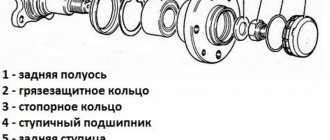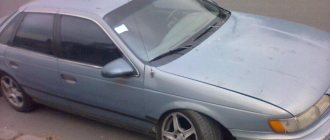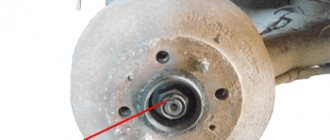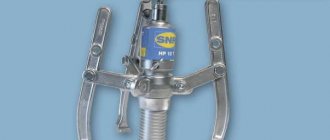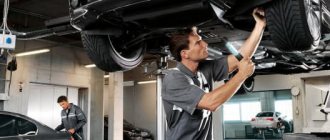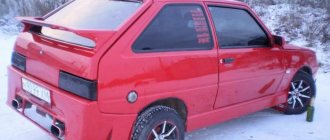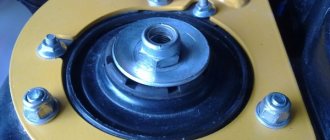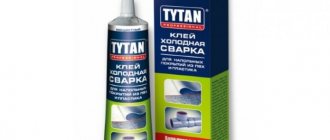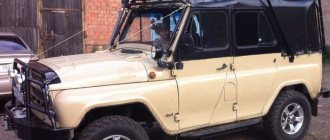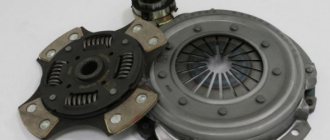Why is there a bearing in the hub?
The wheel rim or the wheel rim itself is attached to the hub flange.
Elements of the brake system are also installed on it. If the wheels attached to the hub are driven, it acts as part of a car transmission. The front steering wheel hub is a steering element. The diameter of the hub is significantly larger than that of its internal hole, where the bearing is pressed. Its length usually exceeds the diameter of this hole. The high strength and design of the hub does not require frequent replacement. At the same time, replacing the wheel bearing pressed into it should be done more often. This part, together with other similar bearings, holds the weight of the machine, allowing the wheels to rotate. In the hubs of driven axles that do not experience heavy loads, single-row tapered bearings are usually used. For driving applications, tapered bearings with two rows are used, which can withstand twice the load than single-row bearings.
Wheel bearings have a closed design, which means they can be used until they are almost completely worn out. They do not need to change the lubricant. However, timely replacement of the wheel bearing is necessary, first of all, because it ensures safe movement under the influence of severe radial and lateral loads.
When to change a bearing
The wheel bearing directly affects the vehicle's ability to move confidently on the road without endangering those inside and outside the vehicle. If at least one of these bearings fails, there is a risk of vehicle uncontrollability and an emergency. In order to understand in time whether the wheel bearing needs to be replaced, you should rock each wheel with both hands every couple of weeks to detect any play or extraneous sounds.
Sure signs that your wheel bearing needs to be replaced are:
- detection of noticeable play in the wheel when it rocks in different planes;
- the appearance of a monotonous hum emanating from the wheel while driving;
- howling or noise that disappears when turning sharply;
- The hub or hub cap is hot to the touch.
The reasons for such phenomena may be loss of lubricant due to high temperature, washout if the car often overcomes water obstacles. Fine sand and dust can get into the bearing housing and have an abrasive effect.
In any case, it is worth thinking about how to change the wheel bearing. After all, its wear also affects the vibration of the steering wheel when the car is moving. Usually this procedure is carried out after 110-130 thousand km. mileage However, this indicator may vary depending on the operating conditions of the car and its driving style. It is believed that every fourth car with a mileage of over a hundred thousand kilometers requires special attention to the condition of such bearings. To prevent problems with them, car owners should make it a rule to regularly diagnose wheel bearings on their own or using the services of a car service center.
At the same time, it is important to remember that attempts to repair it yourself or how to replace the hub bearing cheaper will not lead to anything good, since it cannot be repaired. If it fails, it simply needs to be replaced.
How to properly press in a wheel bearing
At 145 thousand km, such a hum began that all passengers began to unmistakably determine that it was the front wheel hub making noise. But about which, right or left, opinions are divided. Unfortunately, hanging the wheels was not determined. When turning right, the noise disappeared, so one might think that the right bearing stopped humming as it unloaded. Based on this theory, it was decided to change the right one (before the replacement, I drove another 5,000 km, wishing the bearing a speedy death, but it still did not fall apart). Looking ahead, I will say that this decision was wrong, although not useless (the wear of the bearing raceways was already clearly visible). After replacing the right one the hum remained. I had to buy another bearing. After replacing the left one the noise disappeared. An autopsy showed that the noise disappeared when turning right, since the pitting was in the upper part of the outer raceway of the left bearing (and if there was wear on the inner raceway at the top, it would not make noise in the left turn). Conclusion: If hanging the wheels does not determine the specific culprit, then: 1. We change any! (budget option, maybe you can guess), 2. We change both. (especially if the mileage is more than 140,000 km).
So the actual replacement.
If you have hands, more free time than free money, and (or) no desire for car service specialists to study and break repairs for your money, you want to drive after replacement not only to the garage, you want to ruin PSA (since they stopped sell C5) you can replace it yourself. Remove the steering knuckle.
I recently shared with subscribers about refining a homemade hydraulic press
.
And also about how it was used to press out and press in the Ford hub. There were questions from subscribers and just guests about how to properly press the hub without damaging the bearing. I'm telling you. There are three options for pressing the hub into the fist: Method 1
: The simplest is to bluntly press the hub into the fist with a press. In this case, all the hydraulic pressure from the inner race of the bearing passes through the balls to the outer race. In this case, 99% of cases end in damage to the balls and cages and the hub will begin to rustle after 2-3 thousand km. This is usually done by those who press out the hub in this way.
What you need to replace a wheel bearing
To replace a wheel bearing with your own hands, you need to be extremely careful and not overestimate your strength. In a service station, this is much easier and faster to do. Most of these enterprises employ experienced craftsmen who use professional tools to knock the bearing out of the hub.
Having decided to carry out the work on your own, you need to answer the question of how to remove the wheel bearing and how to replace it with a new one.
To do this you need to prepare:
- new bearing, preferably made in Europe, retaining rings and hub nut;
- hub diagram and detailed instructions for carrying out work;
- a repair room with a vice and good lighting of the unit being repaired;
- special device for removing the bearing;
- a set of keys and sockets with a knob;
- round nose pliers, which may be needed to remove the retaining ring;
- lubricant (litol);
- a piece of pipe up to a meter long as a lever.
Before starting work, you should consider in detail how best to remove the wheel bearing. When doing this for the first time, it is better to invite an assistant. The wheel bearing puller deserves special attention during preparation. With its help, you can carefully remove the bearing without damaging the wheel and other parts of the car. It is better to familiarize yourself with its structure and operating principle in advance. Typically, such a wheel bearing puller has a fairly simple device.
Wheel bearing puller drawings.
A 320 mm long stud was also needed and a nut was welded to it. I also pressed the ball from the bearing into the center of the stud.
According to the drawings, they made these:
Cup with mate.
Also two washers measuring 74 mm and 62 mm.
This is what the entire set of tools for pressing out wheel bearings looks like.
In this video, the author shows in detail a wheel bearing puller.
Replacing the front wheel bearing
When deciding how to replace the front wheel bearing, you should consider its location.
After all, the front suspension is the main part that affects the handling of the car. Therefore, it is better to do this work using a puller, which helps to remove such a bearing without any problems. First of all, you need to secure the car in a position convenient for work. Put it in first gear, place chocks under the wheels, and tighten the handbrake. Replacing the front wheel bearing requires careful preparation of the work area. You should carefully examine the parts you are dealing with, figure out how best to remove the bearing, and prepare the necessary tools. It should be taken into account that two bearings can be installed on the front hubs of the drive wheels.
To replace the wheel bearing on the front wheel, you must:
- Using a screwdriver, remove the bearing plug from the front wheel and loosen and loosen the hub nut.
- Hang up the wheel.
- Tie the caliper to the suspension part to prevent it from hanging on the front brake hose. After this, press it out with a screwdriver and remove it from the steering knuckle.
- Unscrew the brake disc bolts from the hub and remove.
- Use a screwdriver to pry up the retaining ring and remove it.
- Using a puller, press out the wheel bearing.
- Inspect the bearing seat, clean it of corrosion and dirt, old grease, and apply new grease.
- Press the new bearing into the hub using a puller without allowing it to become distorted.
- Replace the retaining ring.
- Secure the bearing to the axle with a thrust washer and nut.
- By tightening the nut, adjust the rotation of the wheel to eliminate play.
After completing the work, make a test drive to check for noise in the bearing. After this, check again for play in the steering. There are other ways to replace the front wheel bearing. The knockout method can be used by cutting a pipe of a suitable diameter, heating the hub, etc. They require attention and caution.
Experienced auto mechanics know how to replace a rear wheel bearing. This procedure is much simpler than when replacing the front one. The hub bearings of these bearings on the rear independent suspension are almost the same as the front ones. The only difference is the absence of a steering knuckle. The type of bearing may vary depending on the machine model.
Front hub design and bearing replacement with your own hands
Before replacing the front hub, you need to carefully study its design.
This will allow all work to be done faster.
The design of the hub itself includes the following elements:
- Hub housing.
- Double row bearing. It is pressed inside the body using a special device - a puller.
- Retaining rings - installed in grooves inside the hub housing, designed to secure the bearing.
The steering knuckle is secured to the front hub at the top and bottom. Moreover, on front-wheel drive cars, they are attached rigidly from above to the lower part of the shock absorber strut.
In order to carry out repairs yourself, you need to have the following set of tools: You also need a replacement kit - bearing, hub, new nut (required).
Before making repairs, you need to look at reviews of various manufacturers. Bearings are produced by the following companies (foreign): Before replacing the hub or bearing, you will need to perform several steps: After all these manipulations, you can lift the car and completely remove the wheel. This algorithm is used to replace the front hub of VAZ new modifications - Samara, Samara-2.
Replacing the rear wheel bearing
Before replacing the bearing on the rear hub, you need to remove the wheel and brake drum as usual, and unscrew the hub nut.
The brake pads can be left untouched. After removing the hub using a puller, remove the bearing from its seat. Replacement of the rear wheel bearing is carried out after a careful inspection of the hole in which it was located, cleaning it, and removing possible burrs. The hub must be cleaned of dust and dirt, old grease. The rear wheel bearing should be replaced only after these procedures have been completed and the bearing seat has been lubricated with lithol. To do this, use a puller to press the bearing all the way and install the retaining ring. Reinstall the entire assembly in reverse order. Generously fill the bearing seat with grease. Close it with a plug placed on the sealant.
All about wheel bearing repair
Actually, the procedure itself (we will support it with photographs) for replacing the bearing: — we install the car on a flat surface; — be sure to place shoes under the wheels that we will not repair; — with the keys we tear off the nuts on the wheel and after jacking up, finally unscrew it, the wheel with the disk of God is in a secluded place until better times; — dismantle the fixing pin and unscrew the axle nut; — using wrenches, disconnect the tie rod ends (if we are talking about the front suspension), the lower arm and the stabilizer link — look at the photo: — clasping the hub with both hands and rotating it left and right with careful movements, dismantle the hub.
It is very important not to pull the axle shaft out of the gearbox!
- remove the sealing ring and retaining rings, in accordance with your car model, and using a puller, easily and simply press out the faulty bearing.
Recommendations
Replacing wheel bearings may vary from vehicle to vehicle. Modern cars may be equipped with various easily damaged electronic devices that must be removed when replacing a bearing. Therefore, if you are not a highly qualified car mechanic, it is better to entrust this work to car service specialists.
It is also worth doing a wheel alignment after replacing the wheel bearing. An adjusted wheel alignment will improve the car's road holding on turns and straights, eliminate vibration, and also reduce tire wear and fuel consumption. Vibration may also occur due to a crookedly inserted bearing. To eliminate it, you need to knock out the bearing again and check the tightness of the wheel nuts.
A proven method for pressing out a bearing using bread
There are situations when it is necessary to press a bearing out of a blind hole. The most budget option is to use bread.
- We fix the product in a vice so that the seat is at the top.
- We select the required diameter of the bolt for pressing out.
- Take a soft piece of bread.
- Place the bread in the center, take a hammer and hammer the crumb inside using a bolt with the required diameter.
- We repeat the process of placing bread inside until the used crumb with its mass does not displace the bearing from the seat.
- We clean the bearing seat and carry out the work of pressing the new part into its seat.
There is a possibility of using plasticine or clay, but it will take longer to clean the nest, lubricate it, and carefully put it into operation before updating the product. And the bread is soft, so it does not damage surfaces or scratch walls. Plasticine or clay can leave “traces” and get into small cracks and threads, and this lengthens and complicates the process of cleaning the bearing seat.
Thus, you can use the proven method of pressing out a bearing using bread without fear of consequences. Just do the preparatory work and prepare the tools for repairs. Go for it and you will succeed! The main thing is to believe in the success of the business.
Don't experiment. If you kill a hub or a new bearing, such amateur work will cost more. Issue price 500 rub.
Two pieces of pipe of suitable diameter, a screw with a nut.
I'm in the village, no one has abs
Build a press using a jack.
Remove (knock out) the old bearing, use the old bearing to carefully hammer the new bearing with a sledgehammer.
Every car is different
on the old crown they are conical, and between them there are openings where you insert a drift and knock them out with a sledgehammer, new ones must be hammered in with a pipe of a suitable diameter, first tapping lightly with a hammer so that it pops into the groove.
There used to be a country like a country and the people around were all with their heads and hands
they could do everything themselves with the help of a sledgehammer and some mother. What happened and everyone around became idiots and white-knuckled people?
Mldr, not everyone has become idiots and white-knuckled people) just inexperienced people are asking, is it enough))
businessmen have appeared, for many it is easier to give 2 rubles to a “master” than to do the curling yourself
The main thing is to start, everything is simple. Break it out, they sawed off the inside with a grinder. Drive a new one from the inner race.
A mandrel from an old bearing race and a hammer. I always change this way, silent blocks too. It’s better to use a press to press it out and press it in. Once I had the service person press the ball into the lever. The lever was turned with a press, and since then I have been doing everything myself with a hammer and mandrels.
You can use a jack. Last summer I pressed it with a Prada jack. The main thing is not to press down the clip with balls.
I would also use the press services
although I can do this myself, the year before last I had bearings, I suffered, I almost ruined the bearing, but on the other hand I took it and went to the workshop, they pressed out the old one for me and pressed in the new one, I paid about 400 rubles. Here, correctly written, there is a small jamb, the blow is incorrect and that’s it, you can throw away the expensive bearing.
Jack and pipe. The hub rests against a good stop and the bearing is pressed out through the pipe with a jack.
I used the corner under the bottom of the garage as a support; my garage stood on cinder blocks.
Homemade wheel bearing puller: drawings, photos, videos of a homemade device.
The author decided to make a homemade version of a tool for pressing out wheel bearings, an analogue of the one sold in stores.
Steel plates with a thickness of 8 mm and a pipe with a wall thickness of 7 mm were found as materials for manufacturing.
